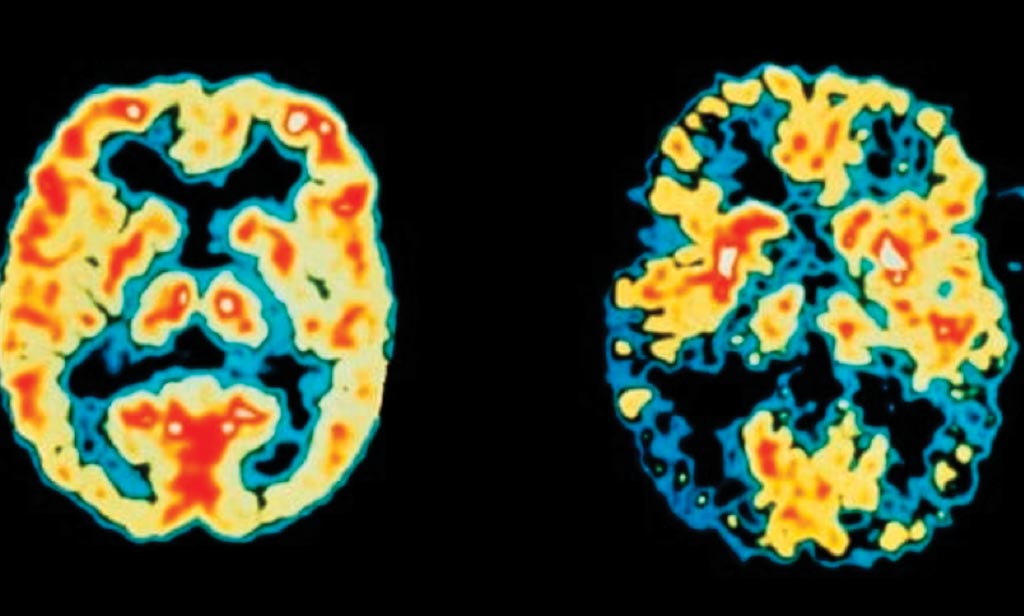Blood Test Detects Brain Damage Years before Symptoms
By LabMedica International staff writers
Posted on 07 Feb 2019
Alzheimer's disease is a major cause of dementia that destroys brain cells and tissue. As the brain damage spreads, it leads to symptoms such as confusion, memory loss, and diminishing capacity to function. Eventually, the person can no longer lead an independent life.Posted on 07 Feb 2019
Postmortem exams of the brains of people with Alzheimer's disease reveal three typical hallmarks: plaques of beta-amyloid protein, tangles of tau protein, and loss of connections between brain cells. Alzheimer's disease mostly strikes people aged 65 years and older, but there are rarer forms that can strike earlier.

Image: Positron Emission Tomography (PET) scans of the brain of a normal patient (left) versus an Alzheimer\'s disease patient, which may have been detected earlier by measuring Neurofilament light chain (NfL) in CSF (Photo courtesy of Science Photo Library).
A team including scientists from the Washington University School of Medicine in St. Louis, (MO, USA) and the German Center for Neurodegenerative Diseases (Tübingen, Germany) studied a rare form that has the name dominantly inherited Alzheimer's disease (DIAD), or autosomal dominant Alzheimer's disease. The data for the study came from the Dominantly Inherited Alzheimer's Network (DIAN), which is an international consortium. The analysis took in data on more than 400 people in the DIAN network. This number included 247 who were carriers of a genetic mutation and 162 of their blood relatives who were not carriers. All the individuals had attended a DIAN clinic and given a blood sample, completed cognition tests of memory and thinking skills, and undergone brain scans. In addition, around half had made repeat clinic visits, with up to three years between each.
Neurofilament light chain (NfL) is a promising fluid biomarker of disease progression for various cerebral proteopathies. Examination of the blood samples from the first visit revealed higher levels of NfL in those people who carried a gene mutation. In these individuals, repeated visits showed NfL levels rising over time. The individuals who did not carry a gene mutation, however, did not show this pattern. Their NfL levels were lower and remained fairly steady over time. The team detected the rise in NfL levels some 16 years before the anticipated onset of symptoms. The team used ultrasensitive immunoassay technology to demonstrate that NfL levels in the cerebrospinal fluid and serum are correlated with one another and are elevated at the presymptomatic stages of familial Alzheimer’s disease.
Further analysis revealed that NfL levels were also predictive for the decline in memory and thinking skills in the cognition tests. Other conditions that damage the brain can also cause neurons to leak NfL. People with Huntington's disease and Lewy body dementia, for example, have higher blood levels of the protein. Blood NfL levels also rise in football players immediately after a blow to the head and in people with multiple sclerosis during flare-ups.
The authors concluded that NfL dynamics in serum predict disease progression and brain neurodegeneration at the early presymptomatic stages of familial Alzheimer’s disease, which supports its potential utility as a clinically useful biomarker. Brian Gordon, PhD, who is an assistant professor of radiology and co-author of the study, said, “This is something that would be easy to incorporate into a screening test in a neurology clinic.” The study was published on January 21, 2019, in the journal Nature Medicine.
Related Links:
Washington University School of Medicine
German Center for Neurodegenerative Diseases













